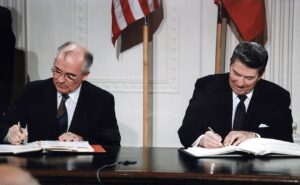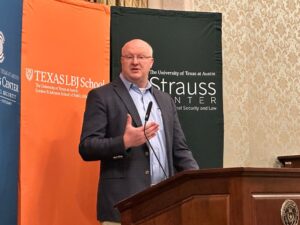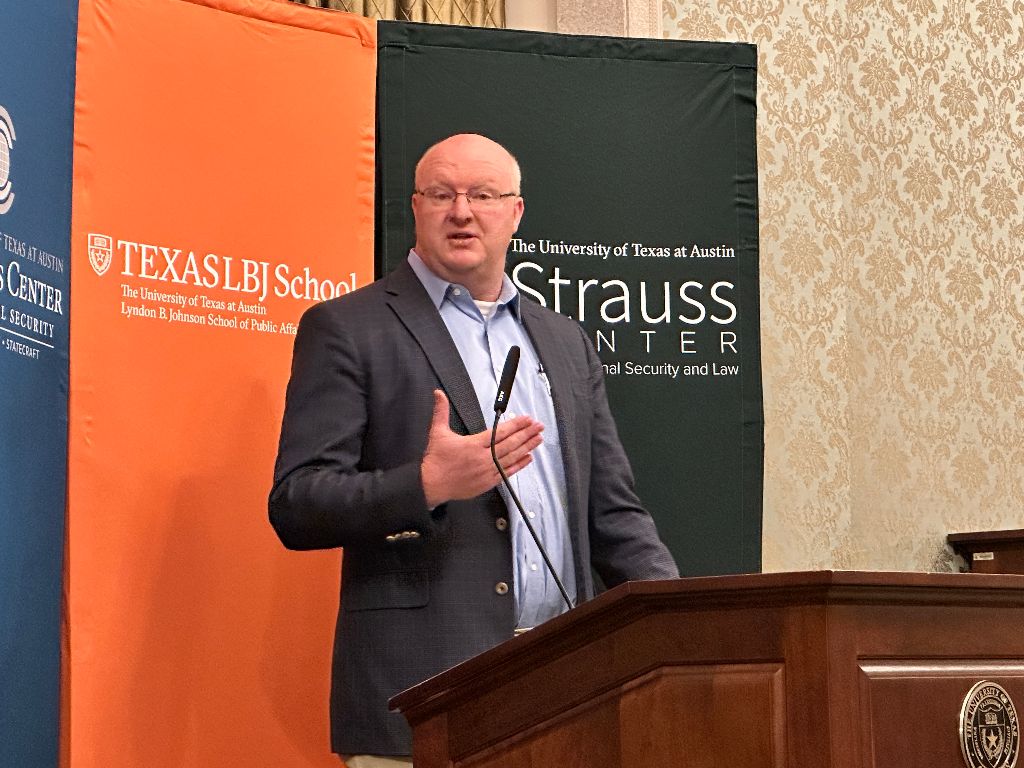When Ronald Reagan was running for the Presidency, many thought he was a warmonger. The fear that he would lead the United States into a bloody conflict was palpably real for millions, not only in the U.S. but other countries.
After 8 years in the White House, his record on that score was nearly flawless. There were no major wars on his watch, with just a minor skirmish: the invasion of the Caribbean island of Grenada, the only time he deployed ground troops (the US death toll there was 19, fewer than many acts of domestic terrorism these days). For Reagan, his battleground of choice was ideas, not a theatre of war.
In a magisterial new book on Reagan’s role as peacemaker, Dr. William Inboden has delivered a fresh look at this critical time in world history, when the Cold War could have turned hot very quickly. Reagan spent much of his career as a Hollywood actor, so he knew how to play to an audience. And he also knew that a mystery could have many twists and turns before arriving at a happy conclusion that had been aimed at from the very beginning by the writer of the play. In the 1980s, Reagan wrote the script and took on the starring role in the greatest unsolved mystery of the 20th century: how to defeat the Evil Empire of the Soviet Union.
Inboden is executive director of the Clements Center for National Security, and associate professor of public policy and history at the LBJ School of Public Affairs here in Austin. He gave a book launch recently in the Main Tower of the University of Texas.
“This era we are living in is an opportune time to write a book on the Reagan Administration’s foreign policy. In terms of history we are now a few decades past it, and we know quite a bit more about how the story ends. For the historians who work in archives the last few years, many of the national security documents formerly classified have been declassified. These offer us an unprecedented window into how the Administration was working. As a scholar I was one of the first people to be able to use these documents.”
Inboden noted that many of the key architects of the Reagan policies are still alive. But, he noted, “it’s a poignant comment on our mortality that just in the last couple of years seven of the people I interviewed have died.”
He amusingly described the book “as a narrative. I tried to do it with enough scholarly rigour and footnotes so that fellow scholars will have plenty of catnip to chew on, but also so that it can be accessible enough so that the reader I had most in mind (Mom) could read the whole thing. And she thinks it’s pretty good!”
The argument he embedded in the narrative is the animating principle of the text, which does indeed read very well. As it adopts a chronological approach, rather than a thematic one, the reader is often presented with a sequence of national policy decisions in disparate parts of the world. For those who want to continue a single thread, such as Reagan and Central America, it is easy enough to do by making a few notes as you go along as to which pages deal with a particular topic. By adopting the chronological approach, Inboden rightly forces the reader to recognize that many issues were being dealt with on a daily basis; trying to juggle their importance and how to respond to various simultaneous foreign crises of “chaos and uncertainties” is the real world presidents find themselves in.
When Reagan became president in 1981, “many experts believed the Soviet Union was strong and resilient, matching if not eclipsing the United States as a world power, and would remain America’s adversary for the indefinite future. Meanwhile the United States felt to many of its own people as a crippled giant, in decline from economic stagnation, military weakness, political dysfunction and international ineptitude.” One notes ruefully how similar such sentiments are to what is felt by millions today, most of whom supported the former president who was twice impeached. The doomsters were wrong then, just as they are today, only now they have become seditionists intent on overthrowing the Constitution. If they succeed, the country will become a crippled giant, just as the Soviet Union had become a “decrepit colossus” in the 1980s. That pithy description comes from Inboden’s book (page 134).
How to Win the Cold War
Reagan encapsulated his Cold War strategy in a simple maxim: “We win, they lose.” He wanted to win without fighting, and was widely derided for this simplistic approach, but as events were to prove, it worked. “Once you drill down, there’s a lot more to it,” Inboden explained. “Reagan said this because he perceived the Soviet Union’s frailty and he developed a strategy to deter its military strength while exploiting its political and economic weaknesses; and also partnering with the Soviet Union to reduce the risk of nuclear apocalypse.”
Reconciling these incommensurate goals was Reagan’s genius. As he writes in the book, “it was a puzzle for the Cold War policy that Reagan would pursue as president: Did he seek victory in the Cold War or just its peaceful end?”
In his talk in Austin, Inboden described how Reagan moved his dual goals forward. “He did this by pursuing what I call the Soviet Union’s negotiated surrender. Negotiated because he favoured diplomacy over war – he wanted to keep the Cold War cold. And he wanted to partner with a Soviet leader to negotiate arms reductions and reduce tensions. His dream was to eliminate all nuclear weapons.” As for the ‘surrender’ part, Reagan “loathed Soviet Communism. He thought it was a plague on all that it ruled and he sought to render it extinct.” He was right that it was a plague, but as the rise of Putin has shown, rendering it extinct was not going to happen. Russia today is just as fully held in the grip of Communism as it ever was, even though that sobriquet is hardly ever used to describe the evil we face now.
As Reagan wrote in his diary at the time, “I think I’m hardline and I’ll never appease them but I do want to try and let the Kremlin see there is a better world if they’re showed by deed if they want to get along with the Free World.” The hardline stance leapt off the page of his diary into a conversation he had with one of his chief negotiators with the Kremlin. It is quoted by Inboden on page 173 of his book. “Well, Paul, you just tell the Soviets that you’re working for one tough son of a bitch.”
Reagan reversed the standard view of his country versus the Soviets. “He saw the Cold War primarily as a battle of ideas that just happened to be between two rival superpowers. Why did Reagan so detest Communism? Some of it was his commitment to political and economic freedom, some was his Christian faith.” Inboden termed the death toll of citizens of Communist countries in the 20th century, estimated to be perhaps 100 million, to be “ghastly. In practice it was a truly barbaric system.”

Star Wars
Inboden described the Soviet Union in the early 80s as a “wounded, cornered bear. It still had the most potent military in the world, but otherwise it was a weak, fragile and insecure system.” To counter that potent military, Reagan “leveraged America’s technological edge not just to outspend the Soviets but to outsmart them.” This ranged from advanced submarines to the system dubbed Star Wars, an anti-ballistic missile defence system whose goal was to neuter the nuclear capability of the Soviets. Considering the importance of the Strategic Defense Initiative (SDI), I was surprised Gen. Daniel Graham merits no mention in the book. In 1993 Reagan said to Graham “You and a small group of dedicated, determined people helped us move the SDI concept over all the roadblocks put up by people of less vision and belief in American capacity.” I spoke with General Graham about SDI during the Reagan years, and received an official citation from him attesting to my support for the initiative.
The Path to Reform
“Reagan pursued policies to free the Warsaw Pact from Moscow’s control, to liberate the Soviet people and to isolate the Kremlin from the rest of the world.” To that end, Inboden highlighted one of the chief findings from his archival work. “Even while he is trying to marshal this pressure strategy on the Kremlin, Reagan still hoped to induce or encourage the Kremlin to pursue the path of reform. One of his strategic assumptions was that the U.S. should promote reform voices within the Soviet Union and pressure it to actually produce a reformist leader. This is one of the new revelations from my research from recently declassified documents from 1981.” Gorbachev didn’t come to power until 1985 but even in ’81 Reagan is very clear what he was striving for.
One aspect of Reagan’s strategy that has received little attention is his faith-based approach. In his book, Inboden states the case baldly: “He saw the Cold War as a spiritual conflict.” Thus, he lobbied the Soviets for the release of a few Siberian Pentecostals, who had been living in exile in the US embassy in Moscow. “He believed,” writes Inboden on page 197, “that supporting the religious freedom of Russian Christians could undermine the idolatrous claims of Soviet communism and weaken the Kremlin’s grip on its people.” A few months later, the Christians were released, and they settled in St. Louis, Missouri. Secretary of State Schultz described their liberation as “the first successful negotiation with the Soviets in the Reagan administration.”
Analysis
While Inboden is generally an admirer of Reagan, he is quite willing to criticise when necessary. There was an attack on the marine barracks in Lebanon in 1983, which killed 299 people. His decision was to do nothing. “Reagan should have retaliated,” he writes in the book. “His failure to do so damaged American credibility, hurt relations with an important ally (France), and invited further terrorist attacks.”
There are many riches in this 592-page book, but two minor points merit comment. I noticed that in a discussion of “heads of state” on pg 62 that Prime Minister Margaret Thatcher is mentioned immediately afterwards. The implication is that she was a head of state, which is not correct; rather, she was head of government.
On page 264 he writes “Many scholars and journalists contend that the multiple Cold War crises of 1983 prompted a ‘Reagan reversal.’ In this view, the escalated tensions, nuclear war scares, and collapse in the Geneva talks prompted Reagan to abandon his confrontational policies and instead seek conciliation with the Kremlin for the next five years. He did not.” My wish here is that he offered the names of at least some of these scholars and journalists. No reference is given to further study this ‘reversal’ contention, which Inboden rightly identifies as erroneous.
This book sets the standard for any future research into the Reagan Administration and foreign policy. While this review concentrated on the Soviet Union, all the other notable aspects of foreign policy ranging from Canada to Japan, the Middle East and Central America are covered. And one gets as close as it’s possible to reach into the closed meetings with Gorbachev and Thatcher to understand how that triumvirate brought the Cold War to a peaceful end. An essential foreign policy book, and certainly one of the most important ever published on the Cold War.
The Peacemaker: Ronald Reagan, The Cold War, and the World on the Brink, is by Dutton. It lists for $35.
www.clementscenter.org

Photo credit: White House Photographic Office – National Archives and Records Administration ARC Identifier 198588, courtesy Ronald Reagan Presidential Library. Image shows the two leaders signing the Intermediate-Range Nuclear Forces Treaty in Dec. 1987.
Lead photo of Dr Inboden by Dr. C. Cunningham
